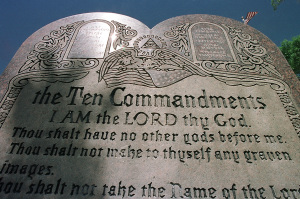Why Congress is Less Bipartisan Today
The decline in bipartisanship in Congress has been a common complaint among pundits and observation among political scientists in recent years. Congressional history shows us that the reasons for the decline have more to do with changes in party coalitions and platforms, and not necessarily changes in the character of our politicians.
Political scientists have been noticing an increase in party unity (how often party members vote the same as others in their party) and party polarization (the ideological differences between the two parties) at least since the 1970’s. Bipartisanship, or party members working with members of the opposite party, has seen a decline over this same period.
Dr. Michael Crespin, who specializes in the study of Congress and elections at the University of Georgia's Political Science Department, made this point in an interview with the Christian Post. “The preferences of the people in the two parties are just further apart. Republicans want conservative things and Democrats want liberal things. They really can't agree on things in the middle,” Crespin said.
To understand why this happened, one must first journey back to the mid-1800s. After the Civil War, support for the Democratic Party was mostly confined to the Southern, former Confederate states. With fewer Electoral College votes than Northern states, Democrats, who dominated American politics from 1800 to 1860, losing only two presidential elections in that period, struggled to win the presidency in the last half of the 19th century and early part of the 20th century. Between 1860 and 1912, Democrats won only four presidential elections
In order to gain political strength, the Democratic Party sought to forge an alliance between Southerners, rural farmers and poor urban dwellers, such as factory workers. William Jennings Bryan, the Democrats presidential nominee in 1896 and 1900, best invoked this effort.
Bryan would be unsuccessful in both attempts to win the presidency, but his efforts would come to fruition decades later with the Great Depression and the election of Franklin D. Roosevelt.
Roosevelt was swept into office on a big broad coalition, including every out-group in American society; farmers, the poor, factory workers, Jews, Irish-Americans, blacks, Catholics, and southerners all came together.
During the Great Depression these groups found common cause. It would be an uneasy coalition, however, that would begin to fracture over time. Southern Democrats were using the power they held in their state governments to deny voting access to blacks, and encourage institutions to discriminate against blacks (in Texas, these efforts included Latinos as well). These were known as “Jim Crow” laws. Non-southern Democrats were fighting, at the same time, to include blacks in their coalition.
Southern Democrats in Congress would first begin to split with their party over economic issues and Roosevelt's New Deal programs. Through the 1930s and 1940s, the national Democratic Party would ignore the plight of blacks in the South in order to keep their coalition with Southern Democrats together. In the 1960s, however, Democrats would proactively reach out to black voters by supporting legislation to overturn Jim Crow laws in the South.
During the period from the 1930s to the 1960s, there was a significant amount of bipartisanship in Congress. Southern Democrats and Republicans worked together to oppose Roosevelt over much of his New Deal agenda. This “New Deal Coalition,” as it came to be called, became, essentially, the governing coalition in Congress during much of this period. And, Southern Democrats and Western Republicans worked together to oppose civil rights reforms.
The Civil Rights Act of 1964 is a good example of the bipartisanship of this era. Non-Southern Democrats and Republicans from the Northeast and Midwest supported it. It was opposed by Southern Democrats who wanted the federal government to allow them to continue discriminating against blacks and libertarian Republicans (mostly in the West) who wanted less government involvement in general. (William Buckley, Jr., one of the masterminds behind this “southern strategy,” would later admit it was a mistake to oppose civil rights reforms.)
White Democrats in the South would begin moving towards the Republican Party, first over the issue of Civil Rights during the 1960s, then over social issues, especially abortion and homosexuality, in the 1980s.
As white Southerners moved into the Republican Party, liberal Republicans moved into the Democratic Party. Rather than having each party comprised of both liberals and conservatives, the Republican Party became the party of conservatism and the Democratic Party became the party of liberalism.
This transition became complete by the end of the 1990s. Today, the former Confederate states, which were dominated by Democrats during and after the Civil War, is strong Republican territory.
As a result, the parties became more polarized and each party became more unified. Democrats voting with Republicans and Republicans voting with Democrats became less common.
The recent fight over raising the debt ceiling and reducing budget deficits is a perfect example. Republicans were unified in their desire for a smaller, less intrusive, government. Democrats were unified in their desire to protect the social welfare programs that their party had been implementing since the 1930s.
This history will be useful to remember when politicians speak fondly of the days of bipartisanship. The bipartisanship was not due to a higher quality of statesmanship among members of Congress (as some would lead us to believe). The bipartisanship of the past was based in part upon ideological alliances that cut across both parties, and in part upon pragmatic electoral calculations. The bipartisanship of the past was due to the circumstances of the past, not to any particular effort by politicians to be more bipartisan.
The bipartisan alliance between non-Southern Democrats and non-Western Republicans to pass Civil Rights legislation was certainly a benefit to the nation, but let us not forget that the alliance between Southern Democrats and Western Republicans to oppose Civil Rights was also bipartisan. So, bipartisanship itself is neither good nor bad, but simply a reflection of the composition of each major political party.
This current period of high party unity, high partisan polarization, and low levels of bipartisanship will likely continue in the near future. It is a reflection of the composition of each political party today, not the character of our politicians.
It will frustrate many Americans, who think highly of bipartisanship, but it will also afford Americans at least one useful advantage-they will know what they are getting at the voting booth. Republicans will mostly bring conservative policies and Democrats will mostly bring liberal policies. “The labels send clear signals to the voters,” Crespin said.




























